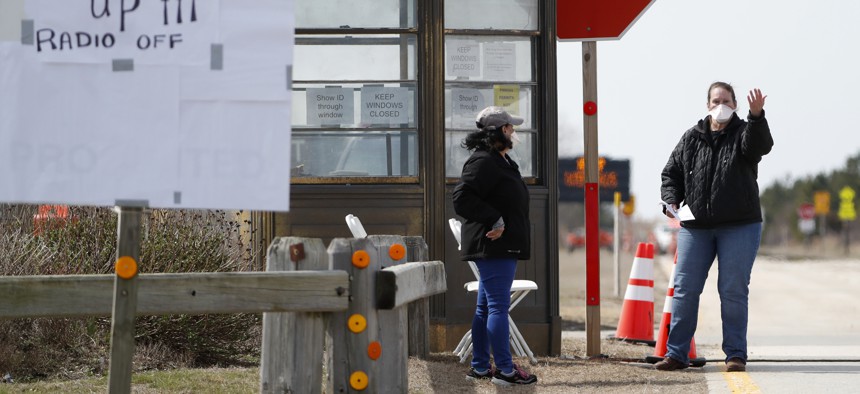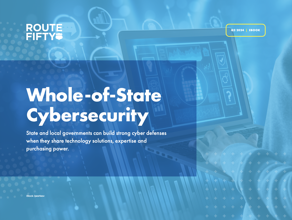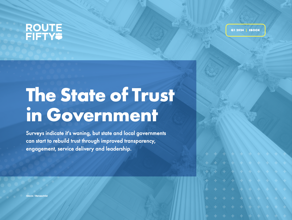‘There’s Never Been Anything Like This:’ Managing the State Employee Workforce

A New York State Department of Health worker instructs drivers to approach a kiosk at a COVID-19 drive-thru testing site at Jones Beach State Park on Long Island on March 18, 2020, in Wantagh, N.Y. AP Photo

Connecting state and local government leaders
An interview about the challenges faced by human resource directors as they figure out leave policies, hazardous duty pay and countless other workforce issues during the coronavirus crisis.
For the past four weeks, the leaders of state human resource departments have gathered on Monday phone calls to talk about the issues they face in dealing with the coronavirus pandemic. Leslie Scott, the executive director of the National Association of State Personnel Executives, hosts these calls, reporting that on April 13 personnel officials from about 40 states got on the line.
We’ve known Scott for twenty years, ever since she became executive director of this state membership association. She can recall no other time when state leaders needed weekly joint calls at this frequency. “We’ve had issue calls and on 9/11 we got all the HR directors on the phone to talk about whether they should send employees home. But there’s never been anything like this,” she told us.
We sat down with Leslie (virtually speaking, of course) to learn what the states’ HR leaders have been discussing, what their biggest challenges have been and what changes are likely when normal government life returns.
Q. How have the nature of the calls changed during this month?
In our first call, the main topic was sending employees home to work—all about stretching the limits of telework and what to do with employees who could not work from home. In the beginning, HR directors had to make decisions quickly and the fiscal impact received less attention. Now, the fiscal impact has become more of a concern.
Q. Do you see signs as to whether there will be furloughs or layoffs, a phenomenon that we’ve started to see at the local level?
We talked about furloughs last week and this week. Pennsylvania furloughed some employees, who are still receiving benefits, and some other states have had requests from their agencies to furlough some employees. But as of this week [the week of April 13], none of the agency requests had been approved. There seem to be some federal red flags that are concerning to people about implementing furloughs.
The reaction I’m getting is that states will muddle through fiscal year 2020 [which ends in June for most states] but come next year there may be a different story. We’ll see what happens with the state budgets and if furloughs and layoffs are going to occur.
Q. With revenues dropping and budgets undergoing cuts, are states thinking about rewarding the employees who are on the front lines and putting themselves at risk?
The issue of hazardous pay has continued to come up in the last few weeks. Most states have not implemented hazardous duty pay or another type of reward or incentive pay. But there are a few that are offering pay increases for employees who risk being exposed. [One state, Michigan, for example, offers up to a $750 premium per 80-hour pay period for critical infrastructure workers, health care providers and emergency responders; in another, Massachusetts, the American Federation of State County and Municipal Employees reached a deal with the state to institute hazardous duty increases of $5 to $10 an hour for health care workers.]
This isn’t always totally a state decision. Some agencies have their own discretion if they can assume some of the cost in their budget. And some states have mechanisms in place within their compensation system to add extra pay if warranted.
Q. Are there other issues that are now emerging a month after government has been significantly transformed?
In our call this week, we had a significant conversation about personal protective equipment and about forcing all employees to wear masks. That has become more of a challenge especially when some states may be having trouble purchasing enough masks.
There was more talk in the last two weeks about the impact on employees. A lot of employees who are working through this are going to be physically and emotionally tired and may just need some time after all of this is over. We haven’t talked about burnout, but I imagine that some burnout is anticipated.
States have employee assistance programs that offer various kinds of counseling and the usage is generally up. These programs have been beefed up to make sure there are enough resources from third party providers. States are logging the types of calls coming in and there is an increase in domestic violence calls and calls about financial issues. There is more general stress and job-related concerns.
Q. How are the HR directors themselves doing?
I think they’re worn out. There’s no question there. They have been working non-stop on this. I don’t think they’ve had time to take it all in. They’ve been so busy. For the past month, they’ve been working exceedingly long hours and all weekends. I’m certain none of them has had a day off in the last month.
Q. What’s been the biggest challenge so far?
It’s all challenging, but honestly, I think that the vast majority of our members’ time is focused on interpreting and implementing leave policy issues.
They have to figure out how new federal policies (The Families First Coronavirus Response Act and the Emergency Family and Medical Leave Expansion Act) fit in with their current leave policies. The question of how much leave to provide and how to provide it is a huge issue and there’s some confusion about how much the federal government will reimburse.
In last week’s call, our members mentioned that initial planning just assumed the situation would last through April. Looking past this month, there’s a lot to reassess, including the impact of revenue shortfalls and the way federal programs will affect decision making on leaves and furloughs.
It is also important for states to track the leave they’re giving, but many of them have relatively antiquated computer systems and they have to go in and calculate this manually. States are already talking about how when this is over, they will have an opportunity to tweak their processes.
Q. Do you have much sense of political differences in the states from the point of view of the HR directors?
I think for the most part politics hasn’t come into play at all. They’re all experiencing very similar issues and want to take care of their workforce. Even though the penetration of the virus has been more intense in some states than others, this is an issue for all of them. Montana has been just as involved in the calls as Washington. No matter how much this is affecting the state population, it is affecting the state workforce, whether it’s made up of thousands or tens of thousands of employees.
Q. When this is over, will the experiences of the pandemic change the way government is managed?
The HR directors are already talking about what will happen when this is over. They’re taking notes on the opportunities to tweak some processes. There are lots of things that they’ll take a look at later on—obviously telework and what happens when employees who are effectively teleworking will be asked to come back to the office. It will be interesting to see that evolution. Paid parental leave was already a big issue before the coronavirus. I think leave issues in general are going to get attention
But everyone is still so consumed with what is happening now and that will be down the road.
OTHER STORIES on Route Fifty:
-
As New York Begins ‘Aggressive’ Antibody Testing, Experts Caution Much Still Unknown About Immunity
- States Start Hiring Battalions of Contact Tracers to Track Covid-19
-
One State Will Use Medicaid Funds to Pay Bonuses to Long-Term Care Workers
-
Chances Dim For State and Local Aid in Pending Virus Relief Deal
Katherine Barrett and Richard Greene of Barrett and Greene, Inc. are columnists and senior advisers to Route Fifty.

NEXT STORY: Amid Crisis, Mayors Can Build a Workforce for the Second Machine Age



